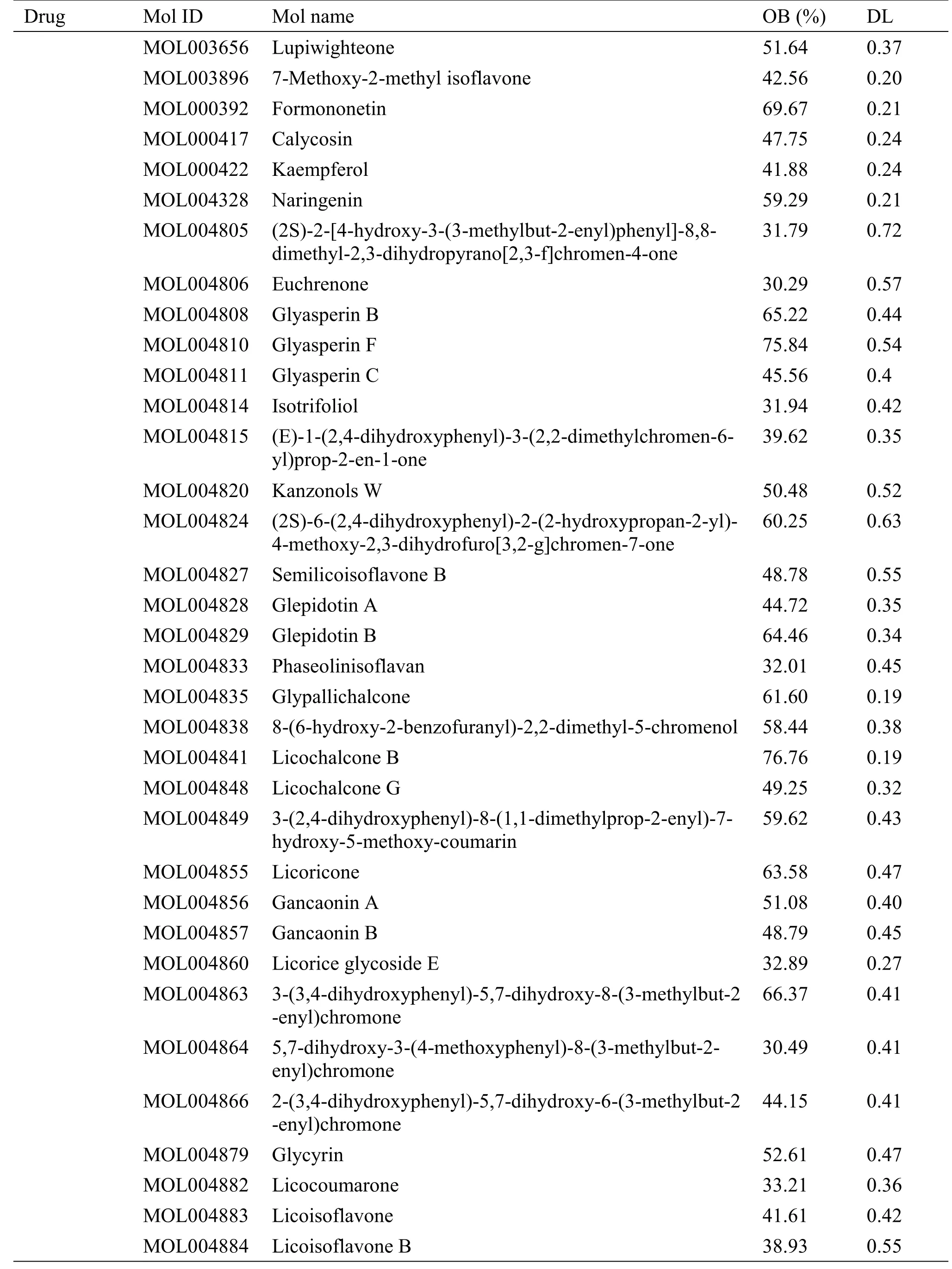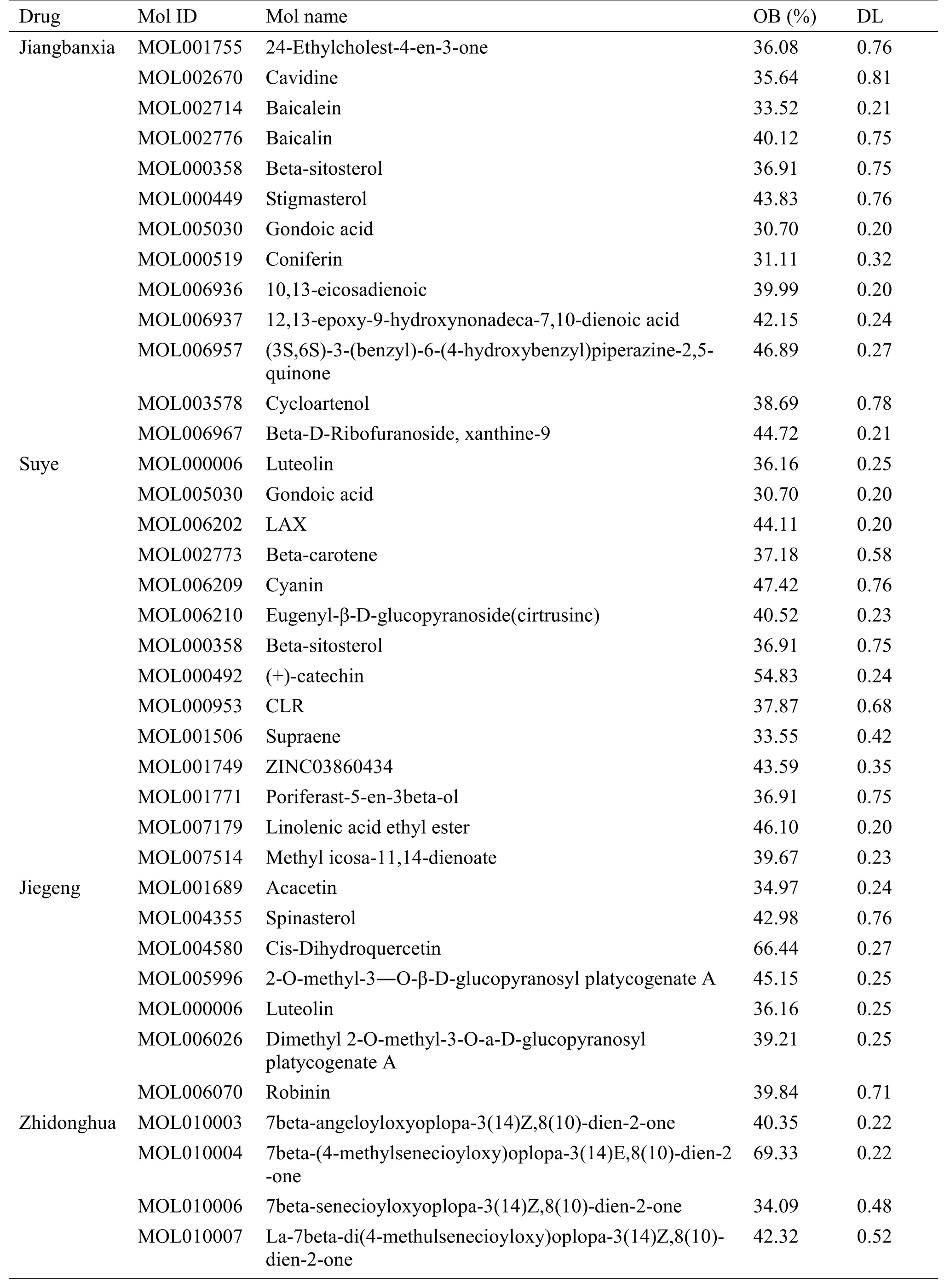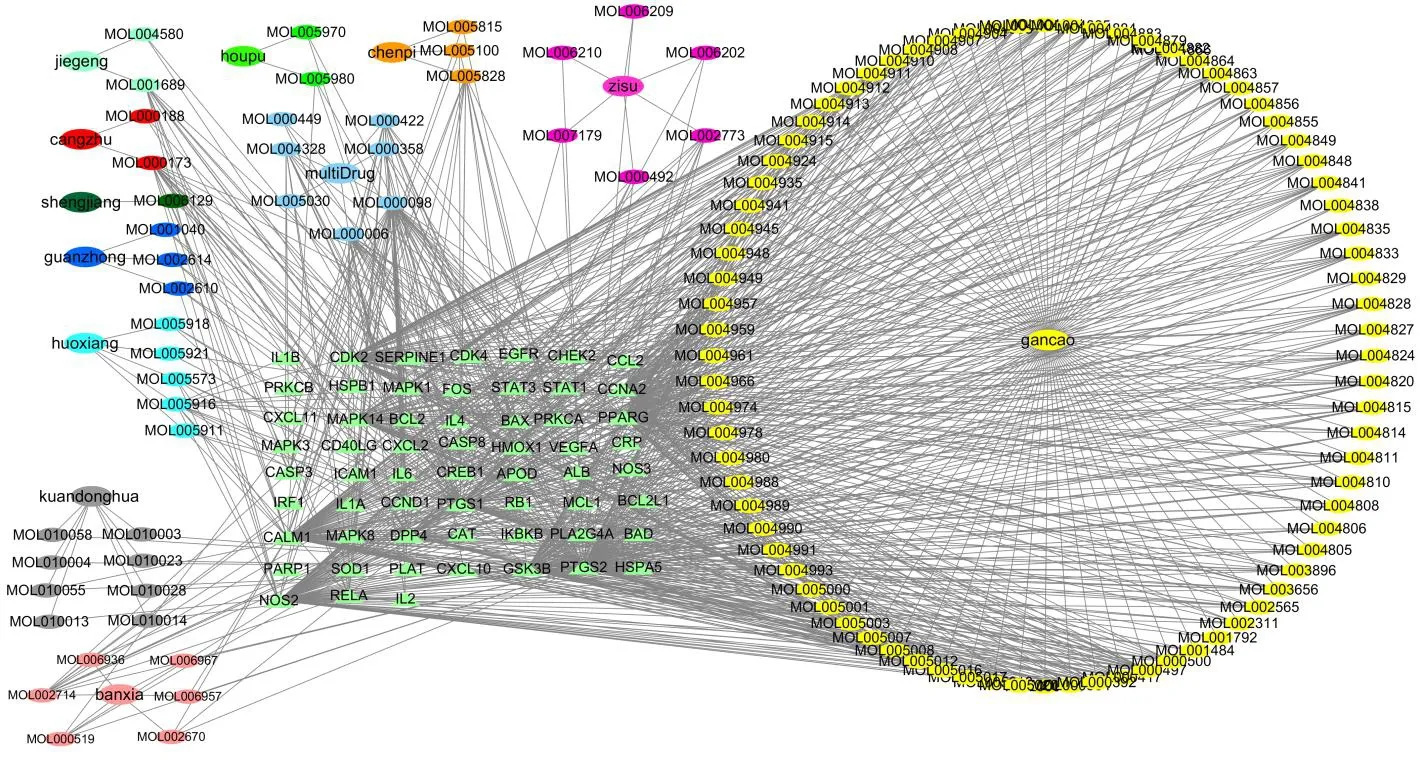A network pharmacology analysis on Jiawei Buhuanjin Zhengqi powder against COVID-19 in children
Jing Lai,Liang-Yi Qin,Zhe Tang,Qi Zhang*
1Pharmacy Department of 923rd Hospital of PLA,Nanning 530021,China;2Traditional Chinese Medcine Department of 923rd Hospital of PLA,Nanning 530021,China.
Abstract
Keywords:Novel coronavirus,COVID-19,Traditional Chinese medicines,Network pharmacology,Jiawei Buhuanjin Zhengqi powder,Children
Background
In December 2019,a pneumonia associated with the coronavirus disease 2019(COVID-19)bursted in Wuhan,Hubei Province,China[1].The disease spread rapidly to other parts of China and some other countries.By 3 March 2021,there were more than 114 million confirmed COVID-19 cases with 2.22% mortality rate in the world[2].
The virus infection belonged to the epidemic disease category caused by external pathogens in traditional Chinese medicine(TCM),and Chinese traditional prescription has been used for prevention and treatment of epidemic disease since ancient times,including COVID-19.In TCM principles,patients with COVID-19 was protected from external pathogens by regulating healthy Qi,dispersing wind and discharging heat,and eliminating dampness[3,4].According to the literatures,children accounted approximately for 1%-5% of diagnosed COVID-19 cases.COVID-19 seemed to be a less severe disease for children than adults.Roughly 90% ofpediatric patientswere diagnosed as asymptomatic,mild,or moderate disease[5].Besides supportive care which included the combination of antibiotics,antivirals,corticosteroids and convalescent plasma,as for pediatric patients suffering asymptomatic infection or early stage of COVID-19,Jiawei Buhuanjin Zhengqi powder(JBZP)based on Buhuanjin Zhengqi powder,which is a famous traditional prescription,was recommended by several clinical guidelines or expert consensus in China,including TCM diagnosis and treatment scheme for children in Shanghai and Jiangsu province[6,7],or Expert Consensus on Prevention of 2019 Novel Coronavirus Infection in Children[8].However,for mild adults patients, guidelines were tend to recommend Huoxiang Zhengqi oral liquid against COVIE-19,which have identical indication with JBCP.We thought this because the unprocessed Banxia in Huoxiang Zhengqi oral liquid may be unsafe for children.
In our study,we analyzed relevant data to explore the effectiveness and potential mechanism of JBZP for the prevention and treatment of the COVID-19 in children.
Methods
The formula collection JBZP
The formula of JBZP was obtained from the Jiangsu Province Diagnosis and Treatment of 2019 Novel Coronavirus Infection in Children:Expert Advice[7],which was composed of 11 kinds of herbs.The formula was shown in Table 1.
Identification of active ingredients and potential targets of JBZP
The chemical compositions of JBZP were identified from Traditional Chinese Medicine Systems Pharmacology Database and Analysis Platform(TCMSP,URL:https://tcmspw.com/tcmsp.php),the active ingredients were collected based on the conditionof oral bioavailability(OB)≥30% and drug-likeness(DL)≥0.18.Aided by the TCMSP database,the potential targets linked to the effects of the active ingredients in JBZP were obtained.
COVID-19-related targets
“Novel coronavirus pneumonia children”was used to search for genes that might be associated with the new coronavirus in the GeneCards database (URL:https://www.genecards.org/).
Network construction
The drug-compound-target network was constructed and visualized using Cytoscape 3.5.1 software.The protein-protein interaction (PPI)networks of core genes of JBZP potential targets and COVID-19-related targets were merged with STRING 11.0 online.
Bioinformatic analysis
Gene Ontology(GO)analysis with biological process(BP),cellular component(CC),and molecular function(MF)was carried out using R 3.6.2.With thresholds of false discovery rate (FDR) < 0.05,functional categories were enriched and the top 20 categories were selected.Kyoto Encyclopedia of Genes and Genomes(KEGG)was used for pathway analysis by R 3.6.2.Pathways that had significant changes with FDR<0.05 and the top 20 pathways were identified for further analysis.The genes that significantly regulated pathways were selected for gene-pathway network analysis,which was constructed using Cytoscape 3.5.1 software to screen out the key target genes that JBZP treated COVID-19.
Results
Active ingredients of JBZP
187 eligible active ingredients were obtained through the TCMSP,9 in Cangzhu,2 in Houpu,5 in Chenpi,11 in Huoxiang,13 in Jiangbanxia,14 in Suye,7 in Jiegeng,22 in Zhidonghua,7 in Guanzhong,5 in Shengjiang,92 in Gancao.OB≥30% and DL≥0.18 served as the criteria(Table 2).

Table 2 Basic information of active ingredients in Jiawei Buhuanjin Zhengqi powder(Continued)

Table 2 Basic information of active ingredients in Jiawei Buhuanjin Zhengqi powder(Continued)

Table 2 Basic information of active ingredients in Jiawei Buhuanjin Zhengqi powder(Continued)

Table 2 Basic information of active ingredients in Jiawei Buhuanjin Zhengqi powder(Continued)

Table 2 Basic information of active ingredients in Jiawei Buhuanjin Zhengqi powder
Core action genes of JBZP and COVID-19
After acquiring active ingredients in JBZP,we next determined the genes linked to the effects of active ingredients through TCMSP.12,921 targets were identified,276 in Cangzhu,1,192 in Houpu,479 in Chenpi,986 in Huoxiang,1,302 in Jiangbanxia,2,481 in Suye,260 in Jiegeng,1,088 in Zhidonghua,125 in Guanzhong,2,225 in Shengjiang,2,506 in Gancao.A total of 257 targets were collected after removing duplication.401 genes related to COVID-19 were retrieved from the GeneCard database using the keywords “novel coronavirus pneumonia children”.Among them,59 genes were shared commonly by both JBZP and COVID-19(Figure 1).

Figure 1 The intersection genes related to the effects of the active ingredients of JBZP and COVID-19 associated genes.JBZP,Jiawei Buhuanjin Zhengqi powder;COVID-19,coronavirus disease 2019.
Drug-compound-target network analysis
In order to explain potential pharmacological effects of JBZP on COVID-19,drug-compound-target network was shown in Figure 2.The network contained 186 nodes(11 herbs,127 compounds in JBZP and 59 compound targets)and 921 edges which indicated the compound-target interactions. 127 candidate compounds had a median of 7.26 degrees,which suggested that most compounds of JBZP might affect multiple targets.Quercetin,Luteolin acted on 41,21 targets,Wogonin,Licochalcone a,Kaempferol acted on 18,17,16 targets respectively,Irisolidone and Nobiletin acted on 14,13 targets.Therefore,they might be the crucial active compounds of JBZP by reason of their considerable positioning in the network.The top 10 targets were prostaglandin G/H synthase 2(PTGS2), calmodulin-1 (CALM1), nitric oxide synthase, inducible (NOS2), peroxisome proliferator-activated receptor gamma (PPARG),prostaglandin G/H synthase 1 (PTGS1),cyclin-dependent kinase 2(CDK2),glycogen synthase kinase-3 beta (GSK3B), cyclin-A2 (CCNA2),mitogen-activated protein kinase 14 (MAPK14),dipeptidyl peptidase 4(DPP4),the degree of them were 121,84,71,68,66,60,59,55,49,43 respectively.

Figure 2 Compound-target network of JBZP.The green triangles represent targets;the red,green,orange,sky blue,pink,violet,turquoise blue,dark gray,dark blue,dark green,and yellow represent the compounds from Cangzhu,Houpu,Chenpi,Huoxiang,JiangBanxia,Suye,Jiegeng,Zhidonghua,Guanzhong,Shengjiang,Gancao respectively.JBZP,Jiawei Buhuanjin Zhengqi powder.
PPI networks analysis
In order to analyze interaction relationship among the 59 intersected genes,we implemented PPI networks analysisthrough the STRING 11.0 software,with a coefficient of 0.400 indicating correlation.The PPI correlation network of JBZP contained 58 nodes and 836 connections,with the average degree of nodes being 28.8(Figure 3).

Figure 3 PPI core network between JBZP and COVID-19.PPI,protein-protein interaction;JBZP,Jiawei Buhuanjin Zhengqi powder;COVID-19,coronavirus disease 2019.
GO and pathway enrichment analysis
To indicate the mechanisms of JBZP from a systematic level,we performed GO enrichment analysis.1,774 GO terms were significantly enriched(FDR<0.05),1,638 in biological process,36 in cellular component,and 100 in molecular functions.Top 20 terms were shown in Figure 4.The highly enriched GO terms in BP,CC,and MF involved regulation of response to oxidative stress,response to lipopolysaccharide,response to molecule of bacterial origin,cellular response to biotic stimulus,membrane raft,membrane microdomain,cytokine receptorbinding,cytokine activity.

Figure 4 GO terms of candidate targets of JBZP against COVID-19.The top 20 GO functional categories with FDR<0.05 were selected.(A)biological process;(B)cellular component;(C)molecular function.GO,gene ontology.
The pathways that were significantly influenced by JBZP in the process of treating COVID-19 were identified by KEGG pathway analysis as shown in Figure 5.169 significantly enriched pathways(FDR<0.05)involved Kaposi sarcoma-associated herpesvirus infection, human cytomegalovirus infection,AGE-RAGE signaling pathway in diabetic complications were identified.

Figure 5 KEGG pathway enrichment of candidate targets of JBZP against COVIP-19.Pathways that had significant changes of FDR<0.05 were identified.Size of the spot represents number of genes and color represents FDR value.KEGG,Kyoto Encyclopedia of Genes and Genomes;JBZP,Jiawei Buhuanjin Zhengqi powder;COVID-19,coronavirus disease 2019;FDR,false discovery rate.
Gene-pathway network analysis
We explored key genes involving in the signaling pathways in the process of JBZP against COVID-19.As shown in Figure 6,the gene-pathway network was constructed based on the significantly enriched pathways and genes which regulated these pathways.The topological analysis of 20 pathways and 45 genes was carried out with BC.The squares represented target genes and the V-shapes represented pathways in the network.The network diagram suggested that transcription factor p65(RELA),mitogen-activated protein kinase 1(MAPK1)and mitogen-activated protein kinase 3(MAPK3)had the most maximum BC and were the core target genes.Other several genes also had larger BC,such as interleukin-6(IL-6),mitogen-activated protein kinase 8(MAPK8),and inhibitor of nuclear factor kappa-B kinase subunit beta(IKBKB).They might be the key target genes for JBZP against COVID-9.This finding revealed that JBZP might have pharmacological effects on COVID-19 by a complex network of compounds and target genes,which required further investigations.

Figure 6 Gene-pathway network of JBZP against COVID-19.The topological analysis of 20 pathways and 45 genes was carried out with betweenness centrality.The orange squares represent target genes and the red V-shapes represent pathways.Big size represents the larger betweenness centrality.JBZP,Jiawei Buhuanjin Zhengqi powder;COVID-19,coronavirus disease 2019.
Discussion
According to the TCM analysis,COVID-19 belonged to the category of epidemic diseases,the target organ location was the lung and then was easy to pass into the stomach or spleen,and the etiology attribute was“damp and toxin plague”.As the same as adults,the common clinical feature in mild pediatric patients shown as thecharacteristicsof “dampness” [9].Bu-Huan-Jin-Zheng-Qi-San was a famous prescription,which came from Prescriptions of the Bureau of Taiping People’s Welfare Pharmacy in Song Dynasty(960 C.E.–1279 C.E.)for treating ulcerative colitis[10],abdominal distention[11],diarrhea caused by dampness,spleen and stomach stagnation[12].Based on the TCM syndrome of mild pediatric patients suffering COVID-19,JBZP was recommended to regulating healthy Qi, eliminating dampness,normalizing stomach function,and stopping vomiting and diarrhea[7],which was acquired due to the differences of individual,regional,and seasonal factors.In this study,the network pharmacology was used to analyze the compounds and targets of JBZP against COVID-19.
Drug-compound-target network analysis shown that PTGS2,CALM1,NOS2,PPARG,PTGS1,CDK2,GSK3B,CCNA2,MAPK14,DPP4 were the top 10 targets related to JBZP against COVID-19,these genes were related with activation of classic inflammatory pathway,such as nuclear factor kappa-B kinase(NF-κB)or mitogen-activated protein kinase(MAPK)pathway,and apoptotic pathways.Seven compounds,including Quercetin,Luteolin,Wogonin,Licochalcone a,Kaempferol,Irisolidone and Nobiletin,which all belonged to flavonoids,might be the crucial active compounds in JBZP against COVID-19.Quercetin,Luteolin,Wogonin,Kaempferol frequently appeared in other COVID-19 therapeutic agents among the key components of the prescription[13–18].Licochalcone a,which was extracted from Gancao,was able to strongly down-regulate proinflammatory cytokines levels[19],such as TNF-α,IL-6,and IL-1β in RAW 264.7 cells and in mice with acute lung injury through suppression of NF-κB activation and p38/ERK MAPK signaling in a dose-dependent manner[20].These compounds mainly played the roles of anti-inflammatory, antiviral and modulation of immune system in the process of treating COVID-19.
According to the PPI networks,58 targets were finally identified and used to carry out the bioinformatics analysis to elucidate the mechanisms underlying the anti-COVID-19 effects of JBZP.GO enrichment analysis results shown the main biological processes included response to oxidative stress and lipopolysaccharide,response to molecule of bacterial origin,the main molecular function was cytokine receptor binding.There were 6 virus-related pathways and 7 inflammation-related pathways in top 20 of KEGG enrichment analysis,which shown that the effects were mainly through Kaposi sarcoma-associated herpesvirus infection, Human cytomegalovirus infection,AGE-RAGE signaling pathway in diabetic complications.The result was different from the network pharmacology study of Huoxiang Zhengqi oral liquid agaist COVIE-19[16],which have identical efficacy with JBCP.Therefore,we presumed that JBZP might relieve symptoms caused by COVID-19 through interfering pathogen invasion process and regulating immune response.
Several references shown that AGE-RAGE signaling pathway had played important roles in the progress of promoting inflammation [21], the activation of receptor of advanced glycation end-products could induce an inflammatory cascade that promoted the expression of proinflammatory cytokines,growth factor,and adhesive molecules though activation of NF-κB[22].Swatantra Kumar reported that S protein of 2019-nCoV was highly glycosylation,and the 2019-nCoV might interact with host receptor using novel glycosylation sites that might affectthe internalization process and associated pathogenesis[23].
Gene-pathway network analysis shown that MAPK signaling pathway and NF-κB signaling pathway were significantly enriched,RELA(the most important gene regulating NF-κB pathway), MAPK1 (ERK2),MAPK3(ERK1),IL-6,MAPK8(JNK1),might be the core target genes.MAPKs and RELA could regulate gene expression,immune response,cell proliferation,apoptosis,and response to oxidative stress,which was one of the mechanisms of immune regulation.
The mechanisms of active and molecular targets of JBZP for mild pediatric patients suffering COVID-19 were explored by using a network pharmacology approach in this study. JBZP might regulate immunological function or glycosylation through the specific biological processes including response to oxidative stress,apoptotic progress,cytokine receptor binding,cytokine activity,MAPK and NF-κB pathways.The network pharmacology appeared to be a suitable approach for the study of complex TCM formulations.
 Precision Medicine Research2021年1期
Precision Medicine Research2021年1期
- Precision Medicine Research的其它文章
- Auricular acupoint application combined with Fujing prescription treatment for patients with premature ovarian failure
- Genetic variants associated with endometriosis patients: a systematic review
- Research progress of non-specific neck pain in traditional Chinese medicine and western medicine
